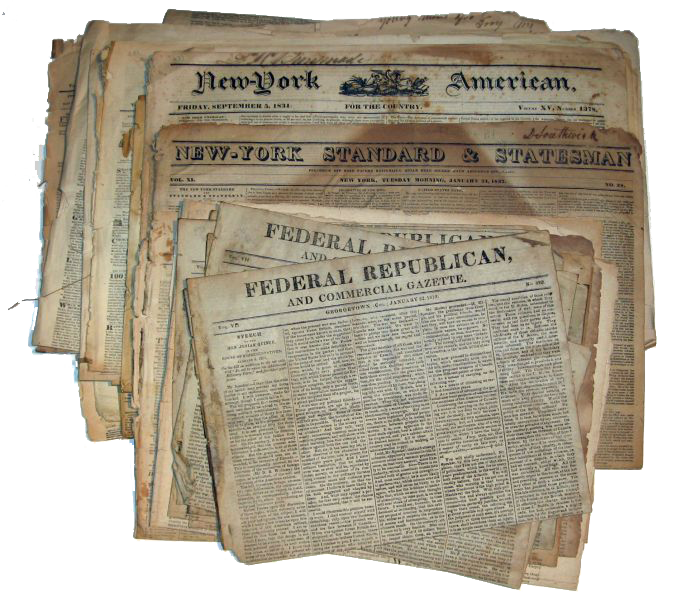
Tracing Your Roots in Eighteenth Century Newspapers, by Robert Barnes
The earliest newspapers in the United States were published starting in 1720. Printing presses were heavy and had to be imported from England. Happy was the colony that could have its own newspaper.
Newspapers printed local news, news from other colonies, but news from Europe often occupied the front page. Marriages and deaths of local inhabitants and noteworthy people from other localities were published. Legal notices, personal notices, ads for runaway wives, servants and slaves, and notices of found livestock appeared.
For the family historian newspapers of the eighteenth century are important because: (1) They may provide information when other sources (e.g., official public records) are not available. Perhaps the courthouse has burned down, or the needed records cannot be found; and (2) They provide interesting information about the actual lives of the ordinary people, such as, “Michael Gilbert, who died 1st inst., aged 74. He had filled several important offices in the county, and lived to see 92 of his descendants, all of unspotted character, then he fell like a ‘full sheaf of ripe corn.’ To lament his death would be to insult his memory.” (Maryland Journal and Baltimore Advertiser 24 February 1784).
Notices of runaways might provide information as to their origins: “Daniel and John Stepelton, brothers, born at Coneck, Ireland, aged 27 and 30, two convict servants, ran away from Andrew Wilson and Henry Rutter living near the Lower Ferry in Susquehanna, Baltimore Co.” (Pennsylvania Chronicle 19 June 1769).
“Harry, a Negro, about 30 years of age, 5′, 3 or 4″ tall, ran away from the plantation, on the North Side of Severn, of J. F. LeFebure, who purchased him from Mr. Hammond at the Ironworks. He had leave to go to Annapolis and see his wife, who lives at the college; she has relations living there/ He has a sister Suke or Sukey and other relations at Mrs. Lawson’s about three miles from Baltimore on the turnpike road.” (Annapolis. Maryland Gazette 27 September 1798).
Sometimes newspapers published stories of unusual marriages, such as “John M. Glathary, stone cutter, aged 85 years, and Miss Margaret Hook, aged 25 years, were married last Thursday evening,” (Maryland Journal and Baltimore Advertiser 28 November 1795).
Occasionally the reports of a marriage were not true, as in, “Daniel Harrison and Miss Nelly Bunker, both of Fell’s Point, were m. last evening.” (Federal Intelligencer and Baltimore Daily Gazette 1 January 1795). “Rachel Bunker, on behalf of her daughter Eleanor, informed the public that the rumor of the marriage was false.” (Federal Intelligencer and Baltimore Daily Gazette 3 January 1795).
Many newspaper items may point the way to constructing a family history, as in the case of Joseph Goodman, a blacksmith, who drowned while attempting to cross over the Falls of Patapsco. He left four children, and a wife big with her fifth (Annapolis Maryland Gazette 12 March 1767). Since we now have an idea of Joseph’s family, we can begin to look for church records and other sources. We can also begin to check for probate records for the Goodman family.
“Joseph Goodman came from Peterborough, England, many years ago to reside in Maryland. He is urged to apply to Evan Thomas of Montgomery Co. or to Elias Ellicott of Baltimore.” (Maryland Journal and Baltimore Advertiser 10 March 1789).” This item gives a clue as to where Joseph Goodman came from.
Newspapers often contained notices from husbands warning others not to trust their wives, but sometimes, the warning was a bit unusual as when Tamor Hicks warned all persons from having any dealing with her children. (Federal Intelligencer and Baltimore Daily Gazette 10 October 1795).
A Select Bibliography of Published Eighteenth Century Newspaper Records
Barnes, Robert, Marriages and Deaths from the Annapolis Maryland Gazette, 1727-1839. Baltimore: Genealogical Publishing Co., 1973.
Bolton, Charles Knowles, Marriage Notices, 1785-1794, for the Whole United States Copied from the Massachusetts Centinel and the Columbian Centinel, Baltimore: Genealogical Publishing Co. (1900) Repr. 2008.
Clift, G. Glenn, Kentucky Obituaries, 1787-1854. Baltimore: Genealogical Publishing Co. Repr. 2006.
DeGrazia, Laura Murphy and Diane Fitzpatrick Haberstroh, Irish Relatives and Friends From “Information Wanted” Ads in the “Irish-American,” 1850-1871. Baltimore: Genealogical Publishing Co. 2001.
Dobson, David, American Vital Records from the Gentleman’s Magazine, 1731-1868, Baltimore: Genealogical Publishing Co., (1987) Repr. 2000.
Eyster, Anita L. , Notices of German and Swiss settlers Seeking Information on Members of Their Families …, 1742 –1761, 1762-1779.“ Pennsylvania German Folklore Society 3:1-41.
Headley, Robert K., Jr., Genealogical Abstracts from 18th Century Virginia Newspapers. Baltimore: Genealogical Publishing Co., 1987.
Hocker, Edward W. Genealogical Data Relating to the German Settlers of Pennsylvania and Adjacent Territory From Advertisements in German Newspapers Published in Philadelphia and Germantown, 1743-1800. Baltimore: Genealogical Publishing Co., (1980) Repr. 2008.
Reamy, Martha. Abstracts of South Central Pennsylvania Newspapers. 3 vols. 1785-1800. Westminster: Family Line Publications, 1988.
Scott, Kenneth, Abstracts of Franklin’s Pennsylvania Gazette, 1748-1754. Baltimore: Genealogical Publishing Co., 1975.
Scott, Kenneth, Genealogical Abstracts from the American Weekly Mercury, 1719-1746. Baltimore: Genealogical Publishing Co., 1974.
Scott, Kenneth, Genealogical Data from New York Newspapers. Baltimore: Genealogical Publishing Co., 1982.
Scott, Kenneth , and Rosanne Conway, Genealogical Data from Colonial New Haven Newspapers. Baltimore: Genealogical Publishing Co., 1979.
Recent Blog Posts




